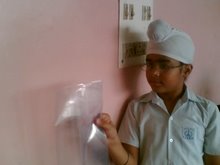
Astronomers are watching a comet break into pieces, practically before their eyes. Their observations, reported by scientists at Johns Hopkins University's Applied Physics Laboratory in Laurel, Md., are giving surprising insight into the structure of these space objects.
Comets are fairly small (about 12 miles across or less) balls of ice, rock, and dust that make long, noncircular orbits around the sun. When a comet gets near the sun, the star's heat melts some of it, creating what looks like a tail. At this stage, it looks somewhat like a tadpole.
Comets sometimes burst into pieces when the sun's heat turns their ice into water vapor. By studying these chunks, astronomers can compare the material at the center of a comet with material at its surface.
The scientists expected that a comet's center would look different from its surface. That's because comets probably formed at the same time as the solar system, so the material at the center has probably remained unchanged for just as long. The surface material, on the other hand, is changed by the sun's radiation.
For the new study, the Johns Hopkins team observed the breakup of a comet called 73P/Schwassmann-Wachmann 3 (SW3). The comet orbits the sun every 5.34 years.
In 1995, SW3 split into at least five chunks. In June 2006, it passed within a relatively close 11.7 million kilometers (7.3 million miles) of Earth. Around that time, it disintegrated even more. Scientists counted 68 fragments.
The two largest chunks are called B and C. Each is several hundred meters wide. The scientists studied both chunks using NASA's Infrared Telescope Facility and the Keck II telescope, both on Hawaii's Mauna Kea. The researchers found that B and C have nearly identical compositions, with the same proportions of substances such as water and carbon dioxide.
Those results suggest that comets have maintained more of their original form than scientists had expected. "We were really lucky" that the comet came close enough for astronomers to make observations soon after a breakup, says lead researcher Neil Dello Russo.
Because this was the first study of its kind, the scientists don't yet know whether all comets are the same, inside and out













































